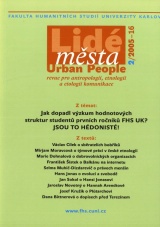Longitudinal Research of Value Structures of Freshmen at the Humanities Faculty of Charles University
Progress of Longitudinal Research on Value Structures 1st-year Students of the Faculty of Humanities, Charles University
DOI:
https://doi.org/10.14712/12128112.3905Abstract
More than 5 years ago, we have initiated work on secondary analysis of extensive empirical sociological research (undertaken in this country, as well as in many other countries) that addresses, to varying degrees, value structures in a society. Examination of values based on collection and processing of empirical data collected through representative sociological research is often subject to doubt. No wonder. The topic of values is profoundly structured, exhibiting significant impacts and relationships, and at the same time, it is subtle, with vague benchmarks and paradigms, lacking generally excepted form. In this context, extensive empirical sociological research is often considered to be tool overly rough, unable to address subtleties and depth of this topic of values. Of course, nobody expected that this approach to cognition of values, based on extensive representative sociological research, would lead to comprehensive and exhaustive results. It covered only examination of trends exhibited in value structure in our society or its parts. The results could only represent (and no less) suggested empirically-verified responses about trends and raw value structures, as indispensable framework of concrete forms, shifts, and trends in value structure of other parts of society, including large social groups, ethnic groups, and to certain extent also personality development. This examination was based on conviction that social framework of the state and development of value structures can not be neglected when examining personality and ethnicity development trends in this country. Available results of many implemented research activities testify about justifiability of this approach to examine value structures.
Downloads
Published
How to Cite
Issue
Section
License

This work is licensed under a Creative Commons Attribution-NonCommercial-NoDerivatives 4.0 International License.



